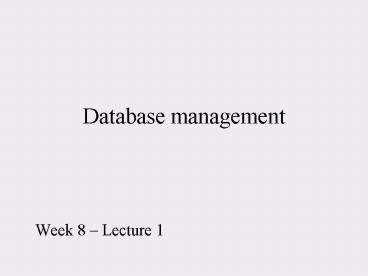Database management - PowerPoint PPT Presentation
1 / 14
Title: Database management
1
Database management
- Week 8 Lecture 1
2
From Data we derive Information
- So the Management of data is at the heart of our
Information System - Information is derived from data by processing
relating, summarising, grouping etc
Knowledge
Information
Data
3
The DBMS (Data Base Management System)
- Sits on top of the O/S File System
- Defines the structure in which the data is to be
organised - Adds and changes data in the DB
- Maintains the integrity of the data
- Finds and presents data to a process
Application processes
Middleware
DBMS
Command language (Shell)
TCP/IP
File manager
Ethernet ATM etc
Device drivers
Task management (scheduler)
Memory management
4
We are going to discuss
- Relational Databases for
- Transaction processing
- Data warehousing
- There are others
- Network databases
- Hierarchical databases
- Object oriented databases
- Hypermedia databases
5
Assumed knowledge
- Concept of tables,
- Primary and foreign keys
- Basic SQL
- Record locking
- A Transaction
6
The Relational model
- Was defined by Dr E F Codd in the 1970s
- He initially defined 12 rules or characteristics
see list by CJ Date in reading material - He developed Relational calculus from which SQL
was derived - Allows read and update by set particularly
important in providing an efficient DB server - Definition of the data (the meta data) is
imbedded in the database, encouraging data
independence - Tables provide structural independence
7
System Issues in DBMS
- Database design The Entity/Relationship model
- Islands of Information
- Need for an organisation wide data dictionary
- Database tuning
- Design for
- Update Transaction processing
- Read Data warehousing
- Distributed databases
8
Database design
- Central to the design of an Information System
- The Entity/Relationship model is the key design
tool - Conceptual/logical model
- Physical model
- Normalisation v Redundancy
- Great for TP databases
- Not necessarily so good for Data warehouses
- Data Integrity
9
Islands of Information
- File systems, which were hard coded into
application programs started this - Still a problem with department/division view of
data, but different views not invalid - The desire and ability to move quickly
- Needs strong guidance from senior management
but not easy to obtain - Now we have inter firm barriers
- Can be overcome with data warehouses
10
Organisation wide Data dictionary
- To avoid
- Islands of information
- Different names for same attribute
- Different domains for an attribute or table (an
airline had 60 different definitions of
passenger) - To ensure
- Careful thinking about organisational data
- Clear definition of attributes
- The problem
- system that affects one department may need
agreement of others - slows the process
- Requires compromise
11
Database tuning
- Best place to start to improve system performance
- The role of the DBA but needs input from the
system designers - Tuning needs a broad and deep understanding of
- The application(s)
- The DBMS
- The Operating system
- The Hardware
- Get the facts volumes, query plans
12
Five basic principles of tuning
- Think globally Act locally
- Partitioning breaks bottlenecks
- Start-up costs are high Running costs are low
- Render unto server what is due unto server
- Be prepared for trade offs
Source Database Tuning, Shasha Bonnet
13
TP v Data warehousing
- TP current data, DW historical data
- TP normalised, DW some redundant data useful
- 10 times more reads than writes
- Writes update
- tables and indexes
- Single records
- Need write locks
- TP needs speed
- Data warehouses
- Have more data
- Need more indexes
- Change less often
- Complex queries large joins
- Combine data from many TP databases data
scrubbing
14
Distributed databases
- TP and Data warehouse
- Partitioned geographically
- Multiple copies for queries
- Serialisation a problem for updates
- Replication
- Two phase commit
- Buffer tables to avoid two phase commit































